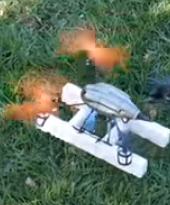Can we convert a $100 drone quadcopter into a river sampling drone?
Can we convert a $100 drone quadcopter into a river sampling drone? |
 | How do you get a sample of river water from the middle of the river without getting
your feet wet or using a boat? Send in an aerial drone of course. Small drones and quadcopters are getting cheaper and more advanced every day. So why not utilise one to collect a sample from the middle of the River Torrens and bring it back to sure to test the pH and the conductivity? The brief was simple. | |
"Convert a cheap quadcopter to make it land on water, pump the water into a
sampling container and bring it back." We would then measure the pH and the conductivity using an
EC-PCSTestr35-Kit when the sample returns to the river shoreline.
See the video results below. Equipment GT3820 - 4 Channel Quadcopter
GT3834 - Water Jet Spray Module Styrofoam board
Small diameter flexible tubing
Small electrical ties
EC-PCSTestr35-Kit - Waterproof Multi-Purpose Meter
Method In order to achieve the desired results we need to construct a base on the quadcopter so
it can land on water, create a method to collect the water sample and then we need to test the
sample itself.
Step 1 - Construct a base so the quadcopter can land on water The floating base was constructed by slicing an "H" shape out of the styrofoam
which could then be attached to the base of the quadcopter. The floating base was cut so that the
already existing plastic legs of the quadcopter could be attached to the foam easily using small
electrical ties.
Step 2 - Modify water jet spray module to collect water sample The water jet spray module is an add on the for this quadcopter to allow you to spray
water from a small reservoir held on board, squirting through a jet out the front. We modified this
using flexible tubing to draw water from below the new base and then squirt the water into a small
sampling container from the front of the spray module. The flexible tubing was used to connect the
output of the spray module into the sampling bottle. The sampling bottle was held to the new base
using the electrical ties.
Step 3 - Measure water sample with the EC-PCStestr35-Kit Once the sample is returned to shore we would use the EC-PCSTestr35 kit to measure the
pH and the conductivity of the sample. Prior to measurement the unit would be calibrated using the
provided buffer solutions to ensure we get the most accurate results.
Results Watch the Youtube video below to see the what happened and the results!
Discussion There were 2 main issues that caused the fatal failure, the first was that the amount of wind was too high for this low cost drone to fly properly in the conditions, especially with the foam base attached (the foam base probably caused a greater "sail" area for the wind to effect). This could be trialed again under completely still wind conditions using the same method and there is a greater chance of success. The other issue was there not being a large enough foam base to land on the water with complete success, when there was a slight tilt on landing it was prone to tipping over and if the blades /where still rotating (and they ht the water) the blades pulled the drone into the water, flipping it upside down. By making the floating base larger this may reduce the issue, but it could also cause and wind to have a greater effect on the drone. The next step would be to try creating a larger base and then also only operating the experiment under close to zero wind speed conditions. | ||
See our other newsletter articles here!
Contact our expert scientists now to get the right meter or data logger to suit your needs and discuss your project.
Phone: 1300 737 871
Email: [email protected]
